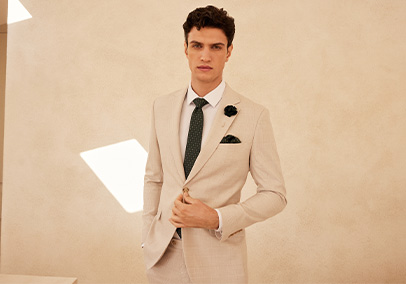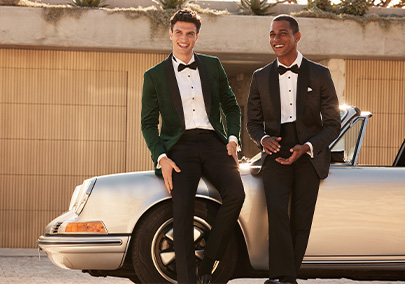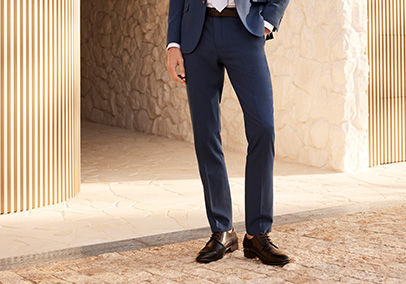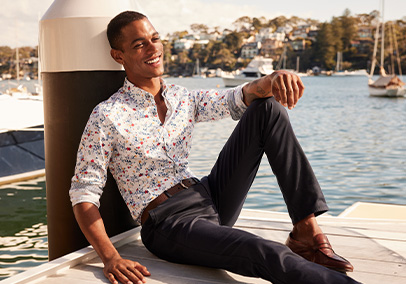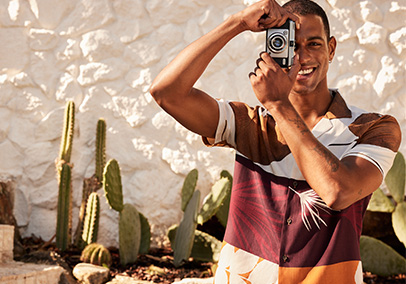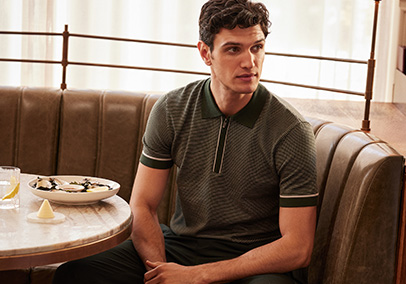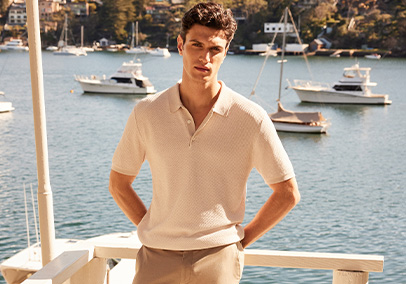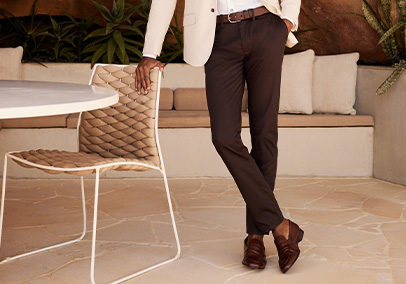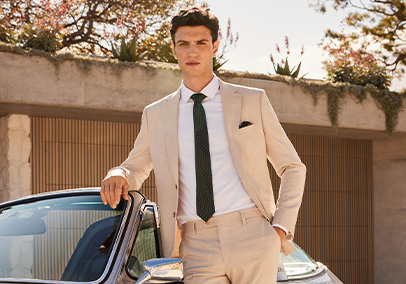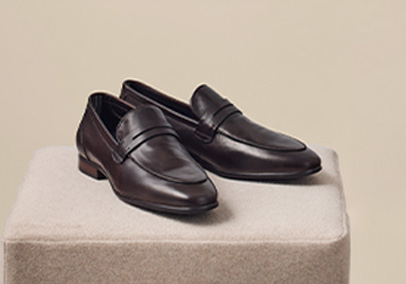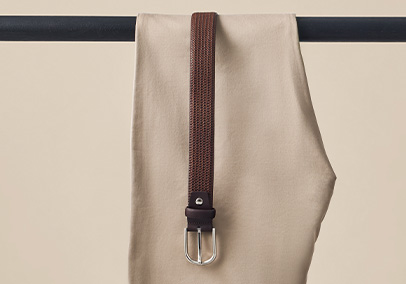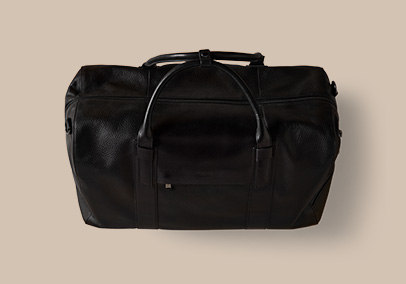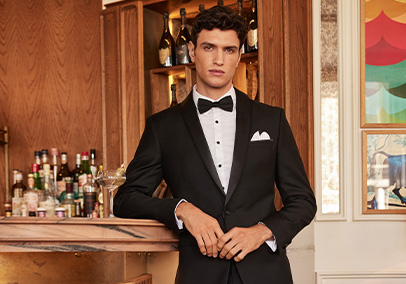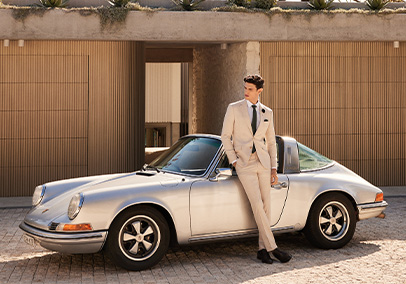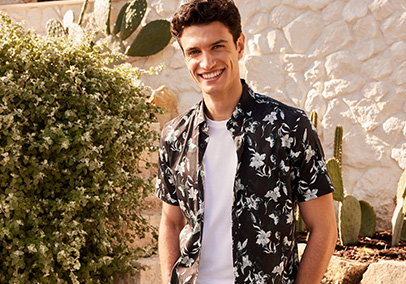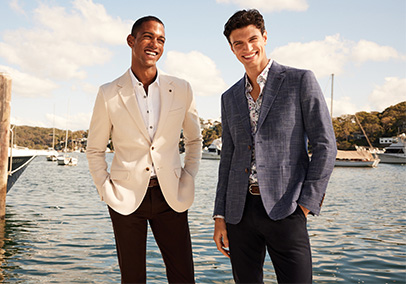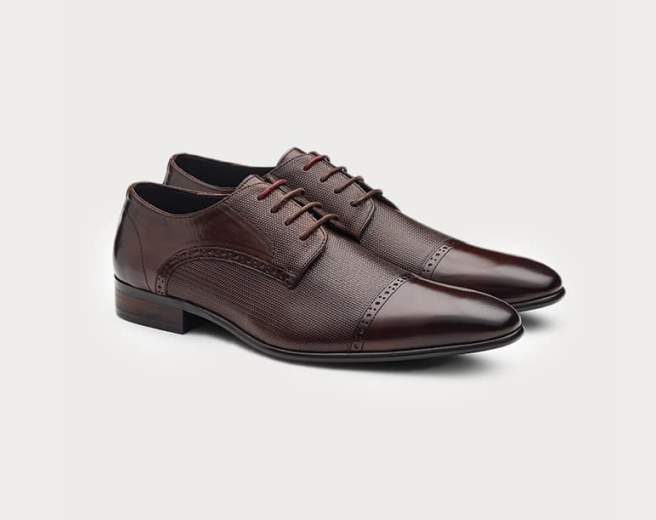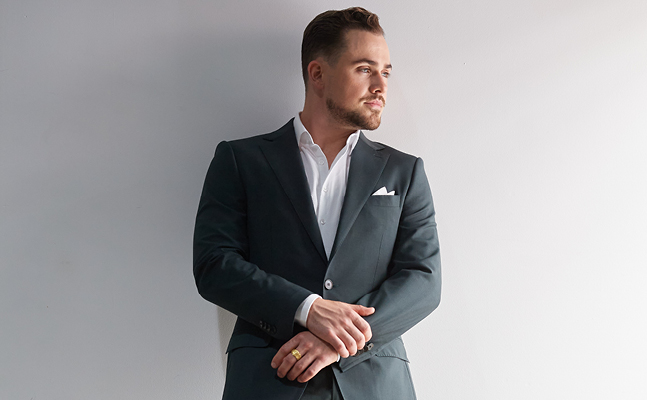- Home
- Style Advice
- Style Advice
- Guide to men's suits
Suits For Men
GUIDE TO MEN'S SUITS
When it comes to Men's Suit's we see the same questions all the time. What suit style should I wear? What does a good suit look like? Does price matter? What are the different suit styles?
At POLITIX, we’re known for our time-honoured craftsmanship and expert tailoring. So, we’ve created this guide to help answer all your suiting questions. Know the different fabrics, styles and accessories to match. Consider this your ultimate men’s suits guide.
01
How To Buy The Perfect Suit

First things first: Where are you going? Is it to a wedding, job interview or a formal? The type of suit you wear depends on the occasion. Generally, a well-tailored navy or dark charcoal suit with a modern fit is a good starting point.
To the modern man, a premium suit is an investment. It’s all about the fit and its make—what fabric is it made of? What does the tailoring look like? Suiting prices can range from $100 all the way to $1000. For a well-made suit, look for the craftsmanship and the finer details. A suit ranging from $300 to $500 is a good middle ground—you’re not compromising on tailoring, quality and value. Our suits specifically are in modern silhouettes and crafted with intricate details. Our finest suits are featured in, The Wool collection, made with Australian wool, with marks of excellent craftsmanship and elevated tailoring.
There are many types of suits like single-breasted, double-breasted, peak lapel suit, notch lapel suit, the list goes on. But the biggest thing to consider is the fit. Ultimately, the best way to describe a great suit is a streamlined suit. Clean lines, clean hems and minimal excess fabric.
In POLITIX, we are well-known for our expert tailoring. For our POLITIX Plus members, we offer a full-service tailoring.
02
HOW SHOULD A SUIT FIT
First of all, you don't have to take your own measurements. Every reputable suit shop should have a tape measure handy, and experts that know how to use it.
We offer a suit measurement service in-store. Visit us and one of our skilled team members will measure and make sure that our suits are tailored to you.
But just so you know, here are the basic suit measurements.


Jacket fit
Start with your chest. This will play a big part in jacket size. Take a tape measure and run it around the thickest part of your chest. And remember, suits are measured in inches, not centimetres. If your chest is 40 inches around, start looking at suit jackets which are 40 or 42.

Sleeve length
Sleeves can be tricky, because a guy's arms don't always neatly match the length of his torso. Ideally, the suit's sleeve should finish right on your wrist, and you should see about one centimetre of shirt cuff poking out. Hang your arms down by your sides: the bottom of the jacket should line up with your thumb.

Shoulder position
There's nothing worse than seeing suit shoulders too wide. This isn't the '80s. We don't need power shoulders anymore. When it comes to shoulders, look at the seam where the sleeve meets the jackets. It should be sitting right on your shoulder. Not too high, and not too low.

Closure
When you’re trying on your suit jacket, do up the top button and take a look in the mirror. The overall shape of the jacket shouldn't change too much. You don’t want to look like a sausage that's been cinched in the middle. Make sure your tie isn't poking out beneath the button point, too. That’s a sign your jacket is too small.

Suit pants
Pants will often need a bit of tailoring to fit just right, and that's okay. They shouldn't be too loose or too tight and they need to fit around your waist, bum, thighs and ankles. Another little detail is the 'break' (the way the trouser hem sits on your shoes): you want to see a little dent, but nothing too baggy. It's what we call a mid-break.
03
Types Of Suits
If you're going for a made-to-measure suit, good for you. That's the best way to guarantee a perfect fit. But it's not the only way.
There's nothing wrong with shopping ready-made or off-the-rack suits - you just need to be aware of the various cuts, styles and size. A lot of the time this will come down to your body type. Slim builds will do better with slim-fit suits, which taper down to the waist. Bigger guys need a bit more room to move, so look for modern or classic fit suits.

MODERN SUITS
Modern fit suits are sort of a compromise between an ultra-slim and a classic fit. We call this our Slim fit suits. They sit on the waist, and they're trim through the hips and thighs. The jacket and leg opening are both slightly tapered, so you get that subtle V-shape going on. Slim fit pants are straight-legged with a more refined fit. This fit is the most flattering for all body types.

CLASSIC SUITS
Classic suits are probably the most common suits out there. These are our Regular fit suits. They've got a more straight-up-and-down silhouette, and a relaxed fit through the shoulders, chest and waist. There's very little tapering going on. Classic suits also have a very straight leg, sitting up on the waistline.

SKINNY SUITS
Skinny suits really depend on your body type. These are our Ultra Slim fit suits. The finest fit with little excess fabric. With a precise cut and super slim through waist, chest and hem, these suits generally fit those with a thinner frame.
04
Suit Fabrics
Suit fabrics are another factor to consider. Sometimes they’re driven by price (cotton suits, for example, are usually much cheaper than wool), but think about the seasons too.
In the height of summer, you're going to boil inside that fancy, Italian wool suit. But in winter, you want that extra thickness. Linen suits don't offer much warmth or insulation, but they're very breathable. At the end of the day, it's all down to personal taste.
Cotton
Chances are the average suit in the street is made of cotton (or at least a Cotton/Polyester blend). Cotton is breathable, durable and relatively soft to the touch. Cotton suits are a good choice for the warmer months.
Wool
A lot of premium European suits are woven from wool. Wool has a couple of advantages over Cotton: it's softer, more textured, and offers better insulation. Our finest wool suits are made from 95% Wool and 5% Elastane; our premium suits are rich in wool with 80% wool, 10% Polyester, 7% Silk and 3% Micro stretch.
Our entire Wool collection has a lightweight, breathable and comfort stretch nature.
Linen
Linen is coming back on trend and it’s a great option for summer. Suits made of linen are light and breathable. Just be prepared for creases.
05
SUIT DETAILS
Finishing touches are what separates cheap suits from great suits with good value.
It’s all about the details: contrast stitching, jacket vents, interior pocket lining, suit buttons and well-notched lapels. With cheaper suits, these details are often forgotten.
LAPELS
Lapels are the folded flaps that sit beneath your neck, and there are several types and sizes. The most common types of lapels are: ‘notch’ (what you see on most business suits), 'peak' (where the lower blade extends above the top blade) and 'shawl' (the rounded, smooth lapel typically on tuxedo jackets). Consider lapel size too: slim lapels are considered more contemporary, while thicker lapels are more retro. As a rule of thumb, don't go beyond 4.5 inches for a notched lapel.

BUTTONS
Check out the sleeve of your suit jacket. What colour are the buttons? What are they made of? Do they clash with the fabric, or provide a pop of colour? Decorative suit buttons are an entire industry in themselves. Ready-made suits will often use polished buttons, but Saville Row tailors have always favoured a matte finish. The general rule is: the paler the button, the more casual the look.

POCKETS
Your pockets, believe it or not, say a lot about your suit. Formal dress suits tend to have 'jetted' pockets, which are sewn into the jacket lining and nearly invisible. More casual suits will usually have 'flap' pockets. They're like jetted pockets, but with a small flap sewn over the top. The least formal pocket is the 'patch' pocket, which is sewn onto the front of the suit. You’ll usually see patch pockets on casual summer blazers, rather than formal or business suits.

JACKET VENTS
Jacket vents are the slits cut into the back of your suit. They're there for ventilation, but they also help the suit fall and move correctly. When you buy a new suit, the jacket vents will often be fastened shut with a slim bit of thread – you’re meant to cut that thread before wearing the suit. Whether you choose one centre vent or two side vents is up to you. It’s a personal choice.

PANT BREAKS
'Pant break' isn't when you sit down after too many slices of wedding cake. It's the little crease that forms when your pant hem hits your shoe. A 'full break' is quite a baggy, old-fashioned look, so avoid anything that droops too long. 'No break' is when the hem sits one or two centimetres above the shoe with no crease—this look is strictly for Ultra Slim fit pants. What you're really aiming for is 'mid break' or 'half break', which is where the pant hem just hits the top of the shoe, causing a slight crease. For a good mid-break, we advise getting one of our skilled team members in-store to measure your pant and tailor it for you.
06
CLASSIC SUITS EVERY MAN SHOULD OWN
There's nothing wrong with going full Harvey Specter and filling your wardrobe with suit after suit. But unless you're in suits every single day, it's not really necessary.

The trick is to pick three or four key styles that give you flexibility: suits you can wear in summer or winter, to a job interview, out on the town or giving your Best Man speech. These four classics are a good start.

THE NAVY SUIT
Elegant, timeless and well-received pretty much anywhere. There's a reason this is the first suit most guys ever buy. If in doubt, go dark navy, not an ocean blue. You'll find it easier to match with various shirts and shoes. And speaking of shoes, navy suits can be worn with black or brown shoes. It's best to keep a pair of each on standby, just in case. Heck, if you're wearing an Ultra Slim fit with mid-break hem, you can even get away with wearing a crisp white tee and white sneakers in summer.

THE GREY SUIT
Grey is a great neutral tone and can range from light stone to deep charcoal. Because of its range of colours, you can wear it for every season. It's regarded as the best transitional suit: something you can wear when the seasons start to change. Grey suits have also been the inspiration for a number of classic styles, including Prince of Wales and windowpane check. When it comes to matching, the white-shirt-black-tie is a reliable combo, but don't be afraid to mix things up and style with pastel patterned ties and silver lapel pins.

THE NAVY DOUBLE BREASTED
Double breasted suits aren't just for grandpas anymore. Some of the most stylish men on the planet rock the double-breasted these days. Technically, 'double breasted' refers to any jacket with two parallel columns of buttons and overlapping front flaps. It's a slightly more formal, old-school look. Although, modern double-breasted jackets are cut shorter, have smaller shoulders, and sit closer to the body. For styling, don't go overboard here: match with a white shirt and muted tie.

THE SUMMER SUIT
There is no one 'summer suit', but every guy should have something ready to go when the weather warms up. Generally speaking, that'll be a linen suit in either grey, cream or light blue. Tan cotton suits are also an excellent option here. They're a little stiffer than wool, but also cooler, helping you breathe and keep a nice silhouette at the same time. Think about your jacket lining, too: unlined or half-lined jackets are great for summer, especially if you're sitting down. They help avoid those sweaty back scenarios.
07
HOW TO MATCH YOUR SHIRT
Colour theory after colour theory. You could write a thesis on the precise colour combinations between shirt, suit and tie. Instead, here's our no-fuss guide to matching suits and shirts.

Navy suit
You basically can't go wrong with a navy suit and white shirt. It's a timeless, elegant combination, and it pairs well with solid tie colours like red, orange or violet. For something more daring, try a pale pink or sky blue shirt with a contrast striped tie.
Grey suit
This will depend on the exact shade of grey you're going for, but grey suits tend to work well with white shirts, pink shirts, black shirts or blue shirts. For an elevated look, match a soft blue shirt with a dark grey suit, navy tie and navy pocket square. The perfect summer suiting.
Black suit
Black suits can be a little lacklustre. They're classic and simple, but with the wrong accessories, the look can be quite plain. A crisp white shirt and striped or foulard gold tie is a good look. As is pale blue. For a modern twist, try a black slim-fit suit and black shirt combination.
08
HOW TO MATCH SHOES

We're almost there. You've got a well fitted jacket, snug, tapered pants. Next are the shoes. Matching Dress shoes and suits is a real skill (we've already written an in-depth guide on the subject). And while there are, in theory, hundreds and hundreds of combinations, know a few simple rules and you'll avoid the worst fashion mistakes.
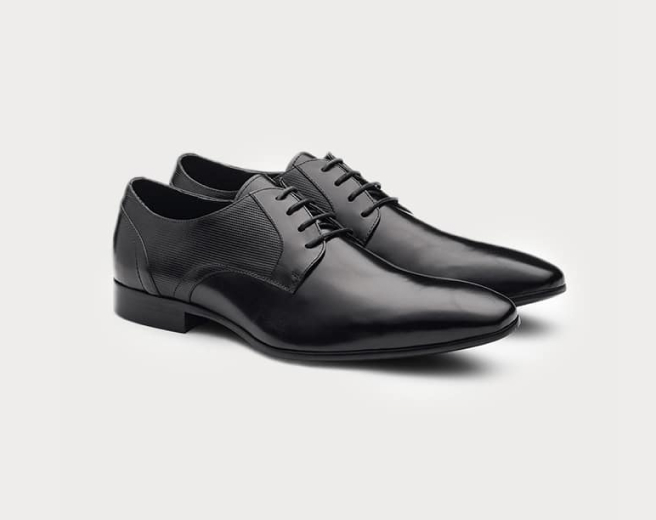
BLACK SHOES
Black shoes work best with black or dark charcoal suits, but you can get away with navy too, if the colour is deep enough. Just make sure you match the belt: black shoes should never be worn with a brown belt. In general, black shoes are more 'formal' than brown. They're good for job interviews, funerals or anything corporate
BROWN SHOES
Brown shoes go with almost anything. Brown oxfords or brogues will look great with a light grey, navy or brown suit. But don't wear them with dark charcoal or (worst of all) black. The formality of those darker tones, mixed with the more casual brown loafer, looks weird and uneven.




